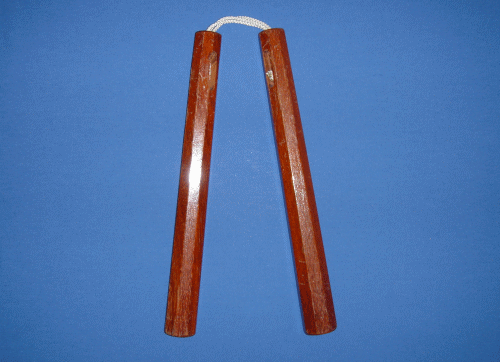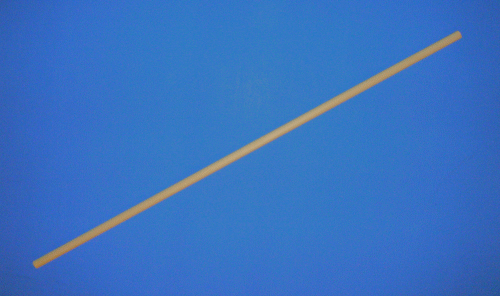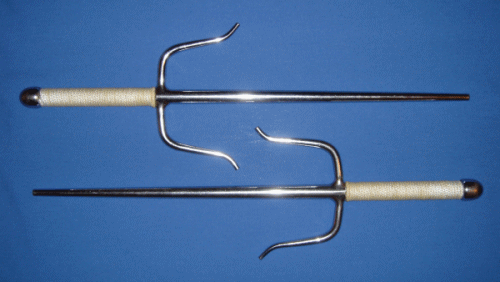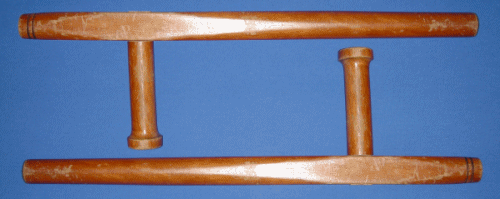In the 1600s the Japanese invaded and conquered Okinawa. Under Japanese rule the Okinawan people were forced to give up all weapons. In desperation the Okinawan people developed methods of using farming implements as weapons to defend themselves against the Samurai. The methods and weapons were so effective that they have changed little over years.
Traditional weapons of Okinawa are taught in the Yoshukai Dojos. Since the weapons are merely an extension of the body, emphasis is first placed on karate training, allowing the weapons to naturally fall into place. For this reason, nunchakus are first taught at green belt level and the bo at the brown belt level. After attaining black belt level and having established a solid foundation in karate, the sai, tonfa, and samurai sword will then be taught. Since the weapons become more difficult to master as you progress in rank, continuous training is necessary to stay proficient.
Yoshukai Karate Alliance Weapons Katas
Nunchaku

Nunchaku is a traditional Okinawan weapon originally used by farmers as rice thrashers. Nunchaku is a flail like weapon made of two pieces of wood, typically about 12 inches long, connected by a length of rope or chain. Several techniques can be used when striking with nunchaku, the most common of which involves the wielder swinging one end of the nunchaku thus allowing the other end of the nunchaku to flail out towards the opponent at great velocity. Nunchaku is also an excellent weapon for blocking attacks and trapping an opponent’s weapons or wrists.
Nunchaku Katas
Kihon Kata
Kihon Kata Shodan
Kihon Kata Nidan
Kihon Kata Sandan
Bo

The bo, also know as a staff, is a long wooden pole typically about 6 feet in length. The bo was used by farmers in Okinawa to herd animals or placed across the shoulders to carry supply baskets or water buckets. The bo is a very efficient weapon that enables the wielder to strike with either end of the weapon thus allowing multiple strikes to be delivered in rapid succession. The bo also has the added advantage of reach which allows a skilled practitioner to strike an opponent while remaining out of the opponent’s reach.
Bo Katas
Kihon Kata Shodan
Kihon Kata Nidan
Kihon Kata Sandan
Sho No Bo
Shoun No Kon
Kumi Bo
Sai

The sai was originally implemented by Okinawan farmers as a short pitchfork used for digging, pitching straw or hay, or planting seeds. The sai, commonly misidentified as a short sword or long knife, does not have any sharp edges. Instead, the sai has a long central tine with a shorter tine to either side that protects the hand. The tines of a sai are rounded or octagonal ending in rounded points. The hilt of a sai is typically wrapped in leather ending in a pummel that is slightly larger than the hilt. The sai is a very versatile weapon that can be used for stabbing, punching, and smashing. The sai is also an excellent defensive weapon because it can be held with the central tine resting against the wielder’s forearm. This allows the wielder to block attacks with the sai instead of the arm. Additionally the sai can be used to trap an opponent’s weapon or wrist.
Sai Katas
Zenshinkotai
Shihohai
Rohaisho
Rohaidai
Tenshin
Mugen
Bassai
Yosei
Tonfa

The tonfa was developed by Okinawan farmers as a grinding instrument for rice, beans, and grain. Tonfa are Made of wood and should extend slightly past the wielder’s elbow when held by the handle. The tonfa can be used for punching or striking. Striking with the tonfa is accomplished by holding the handle of the tonfa and swinging the end of the tonfa toward the opponent. Also effective as a defensive weapon, the tonfa can be laid along the forearm allowing the wielder to block attacks with the weapon instead of the arm. The tonfa is such an effective weapon that it has been adopted by law enforcement agencies around the world as the police nightstick.
Tonfa Katas
Shihohai
Rohaisho
Rohaidai
Niseishi
Mugen
Katana

The katana, also known as a Samurai sword, is a long sword with a slightly curved blade. A curved blade creates a larger cutting surface than a straight blade of the same length. When striking with a katana the wielder swings the sword in a manner that causes the sword to cut the opponent instead of chopping.
Katana Katas
Iai (1 – 10)
Weapon vs. Weapon
Bo Tai Bo
Bo Tai Sai (1 – 6)
Bo Tai Tonfa (1 – 6)








